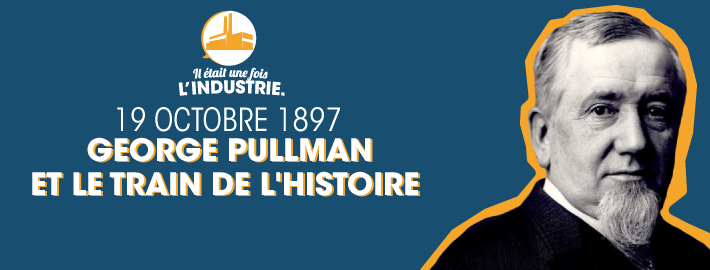GLOBAL
INDUSTRIE
News
Share on

19 October 1897: George Pullman and the train of history
This week, we profile an American industrialist whose name went down in history for the best of reasons… but also for the worst.
THOSE WHO LOVE HIM CAN TAKE THE TRAIN…
The destiny of George Pullman, who was born on the 3rd of March 1831 in New York State, quickly became clear. His father, a mechanical engineer, found a job working on the widening of the Erie Canal. His mission was to move houses and reinstall them on better and more permanent foundations. Thus made aware very early of the issues involved in transporting houses, the young boy left school at only 14 and quickly became a traveling salesman for Albert, his cabinetmaker brother. This job led him to travel all over the country, preferably at night, sitting in trains which were all equally uncomfortable. Thus it was that his big idea came to him: the sleeping car.
Money being crucial, however, he had to wait to have the means to fulfill his ambitions. In 1859, with Albert, he launched a civil engineering company in Chicago specializing in building hotels. The city being built on marshes, they followed in their father’s footsteps and distinguished themselves in 1861 by using jacks to move Tremont House, a six-story brick hotel. Having become a local celebrity, George persuaded a local railway company to entrust him with two railcars. He spent a fortune on a prototype which he called the "Pioneer", equipped with bench seats which converted into bunk beds, a toilet cubicle with hot water, a closet and luxurious decorations. The only problem was it weighed 27 tons and had a height which prevented it from passing under certain bridges, a fact which seemed to ring the death knell for its hopes…
It was another funeral bell which was to revive these hopes, however. On the 14th of April 1865, President Abraham Lincoln was assassinated by John Wilkes Booth. Keen to fittingly honor the winner of the Civil War who had just abolished slavery, Colonel Bowen, who was in charge of his funeral, was persuaded by George Pullman to use the Pioneer to transport his body across the country and to adapt the tracks to the size of the car for the occasion. This baleful task having been accomplished, the clever inventor took advantage of stops on the way back to Washington to invite dignitaries of the towns he passed through to receptions in the now famous railcar. It was thus that the "Pullman car", with its foldaway beds and its porters, was adopted by the various railway companies across the country, enabling its creator to found the Pullman Company in 1867. This company became so successful that in the early 1980s it built a town named after it in Illinois which was intended to be a solution to poverty and workers’ agitation…
… OTHERS WILL BE AT BATTLE STATIONS
It would be wrong however to believe that his railroads were paved only with good intentions. The paternalistic and omnipotent nature of the "benefactor", who oversaw his workers’ social practices, was quickly singled out for criticism: independent newspapers and public meetings were banned, inspectors entered homes to check tenants’ cleanliness, houses differed according to the occupants’ social status, etc.
Thus in 1894 began what was to go down in history as the “Pullman Strike”. On the 11th of May, 3,000 employees of the Company began a movement in reaction to wage cuts which paralyzed rail traffic throughout the area west of Chicago. The American Railway Union (ARU), the first national labor union in the sector, asked its sympathizers to boycott Pullman cars, after the refusal of he bosses’ organization, the General Managers Association (GMA), to negotiate. The strike spread throughout the country. In June, 260,000 railway workers took part in the boycott of Pullman cars. The GMA recruited strikebreakers and called in the Illinois militia. The US President, Grover Cleveland, authorized railway companies to raise their own private militias. Several union leaders were arrested. On the 6th of July, two strikers were shot dead. In reaction, hundreds of railcars were burnt. The militias opened fire, killing 13 people and wounding 53.
The movement was bloodily repressed. Thus, when the inventor of sleeping cars died in Chicago on the 19th of October 1897, at the age of 66, he was buried at night in a coffin sealed inside a steel and concrete vault. Several tons of cement were then poured on top to prevent his body from being dug up and desecrated.
"In trains, a pervert always books his seat in the rear carriage." – José Artur
OTHER EVENTS WHICH HAPPENED THIS WEEK:
- 18 October (1963): the French rocket Véronique launches a capsule carrying Félicette, the first and only cat to make a sub-orbital space flight
- 19 October (1939): founding of the CNRS, the Centre National de la Recherche Scientifique
- 20 October (2018): the European and Japanese space agencies launch the BepiColombo Mercury exploration mission
- 21 October (1833): birth of Alfred Nobel in Stockholm
- 21 October (1899): launch of the Narval, the first true French submarine
- 22 October (1797): first parachute jump by the French balloonist André-Jacques Garnerin
- 22 October (1975): the Soviet probe Venera 9 lands on Venus
- 23 October (2018): the Chinese President Xi Jinping opens the world’s longest sea bridge, linking Hong Kong to Macao
- 24 October (1960): the Nedelin catastrophe, a Soviet state secret
- 24 October (2003): Concorde’s last flight
2021.10.18